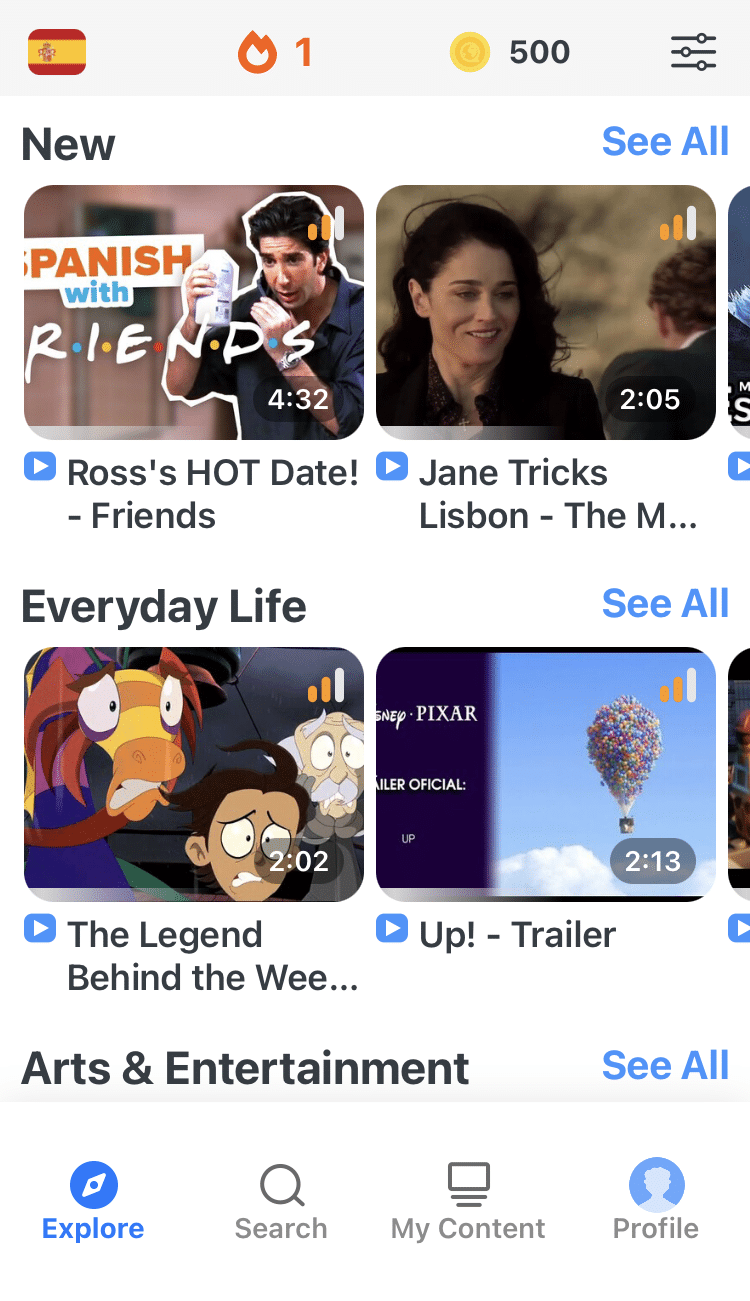
An Introduction to the Shadowing Technique
You know what parrots are famous for: repeating what you say, for better or worse.
With a technique called language shadowing, you’ll be acting like a parrot does—repeating what you hear in a foreign language, even if you don’t fully understand it right away.
The difference is that over time you’ll actually start to learn your target language through this repetition and imitation.
In this post, we’ll show you how this unconventional learning method works and how you can start shadowing successfully in seven steps.
Contents
- What Is Language Shadowing?
- The Link Between Shadowing and Pronunciation
- Who Should Consider Language Shadowing?
- How to Shadow Successfully
- Start Integrating Shadowing into Your Language Learning Routine
- How to Find the Right Materials for Your Target Language
- Knowing When to Stop Language Shadowing
- An Alternate Take on The Shadowing Technique: Chorusing
- And One More Thing...
Download: This blog post is available as a convenient and portable PDF that you can take anywhere. Click here to get a copy. (Download)
What Is Language Shadowing?
Put simply, language shadowing is repeating aloud what you hear, word for word, with as little delay as possible.
Linguist and polyglot Alexander Arguelles is considered the inventor of language shadowing. He’s created a series of videos focused on teaching and demonstrating the technique.
Arguelles defines shadowing as a language learning technique where the student listens to a recording of target language audio, and simultaneously echoes what they hear. Shadowing is designed to force you to focus on the sounds of your target language and develop pronunciation that mimics a native speaker.
Ideally, you’ll eventually also start to absorb vocabulary, grammar rules and natural sentence structures.
Arguelles recommends doing three things while shadowing to improve your focus and memory:
- Walking outside swiftly
- Maintaining a good posture
- Repeating aloud in a loud, articulate manner
While Arguelles may have developed the shadowing technique into a concrete learning method, there are people who’ve been using shadowing prior to it having this name.
The Link Between Shadowing and Pronunciation
To understand how shadowing works, let’s first think about what pronunciation is and what it involves. Looking at it in a new way might be helpful for your learning perspective.
Consider this: Every single language has words and sounds that blend together when spoken naturally.
If you’re a native English speaker and you read that last sentence aloud in a normal voice, you’ll probably join “single language,” “blend together” and “spoken naturally” into single words, with no pause between them.
Not to mention, you’ll probably say “words ‘n sounds” instead of “words and sounds.”
Shadowing will not just help you learn a language, but it will also help you improve your accent, pronunciation and overall fluency when speaking the language.
Who Should Consider Language Shadowing?
The shadowing technique works best for a few types of people:
- Auditory learners
- Students who learn best with structured study plans
- Polyglots (if you’ve already learned a foreign language, speaking with unfamiliar sounds isn’t as scary)
Even if you don’t fall into one of those groups, this out-of-the-box learning method can help energize your same old, same old study plan. Plus, the focused pronunciation practice is inherently valuable, especially if you don’t have lots of other opportunities for target language speaking practice.
You’ll also develop your target language intonation, the natural “melody” or pattern of your speech. Depending on the emphasis you consciously or subconsciously place on certain syllables or words while speaking, a sentence can have a slightly different meaning. Intonation develops over time and is affected by how we hear others speak.
So with language shadowing, our intonation develops as we listen and repeat, the same way it does with our native language. Both accents and intonation are crucial to achieving language fluency, so you sound much more natural when you speak, instead of like you’re reading from a textbook.
Of course, there are many different ways to approach learning a new language, and shadowing doesn’t work for everyone. Like any other method, your individual success with shadowing is dependent on how much time, effort and dedication you put into it.
How to Shadow Successfully
Shadowing is a very successful and useful language learning method when applied correctly.
The guide below is based on the structure laid out in Arguelles’ video “Shadowing Step by Step.” We recommend watching this video for a more in-depth analysis of the different stages of language shadowing.
1. Choose Your Audio Resource
Before you choose an audio resource, there are a number of factors you should consider:
It’s important to consider your language level. If your source is too advanced or too easy, the shadowing technique may be less effective.
You’ll also want to make sure your audio resource has a text component with an English translation (for example, an e-book version of your audiobook in both languages). You’ll see why in the steps below.
But what kind of audio should you be listening to?
Audiobooks read by a native speaker in your target language are one great option—LibriVox is a great place to find audiobooks in many different languages. For shorter, more digestible listening, try podcasts in your target language.
Videos featuring native speakers are also highly useful for shadowing because you get to see the language being used in context, which helps you remember the meanings faster.
You can also get shadowing material with a language learning program that utilizes audio components. Language websites and apps tend to present information in multiple formats, instead of just focusing on audio. This can ultimately make the shadowing experience more engaging and immersive.
Whatever resource you choose, you’ll want to make sure it’s convenient to use and plentiful in content.
2. Practice in Your Native Language First
To ease yourself into the method, try it with a recording of yourself in English or your native language.
Read a text aloud, slightly slower than normal, for two or three minutes. Then play back the recording and try to repeat after it. You don’t want to wait for a sentence or even a word to end before repeating it—your repetitions should be as close to simultaneous with the recording as possible.
This will get you accustomed to the slightly unusual feeling of speaking and listening at the same time. Now you’re ready to try it with a foreign language.
3. Just Listen and Focus on the Sounds
Listen to the dialogue in your target language with headphones or earbuds a couple of times without reading any transcript or speaking aloud. Focus on the sounds and feel the words in your mind, even if you don’t have a clue what they actually mean.
The most important part of this step is to acknowledge and focus on the target language before you move on to the next stage.
4. Listen and Repeat While Walking Around
An unconventional but critical part of language shadowing is walking around while listening to and repeating your audio resource.
As a non-native speaker, early on it’s tricky to speak in a foreign language while doing something else, even the simple task of walking. This exercise is designed to get you out of your comfort zone and focusing actively on what you’re hearing. It also gives a regimented feel to your shadowing practice, making it harder for you to space out or get lazy with your pronunciation.
Walking or pacing while shadowing will seem uncomfortable at first, especially since many of us are inclined to sit down while studying. But as you keep going it’ll become easier and more natural.
Do this step several times until you feel comfortable repeating all of the sounds.
5. Listen and Repeat While Reading the English Translation
Now you can start learning what you’ve actually been saying this whole time!
Go back to the start of your audio passage and shadow while reading the English translation of your book or transcript. As Arguelles puts it, this will give you a “global” understanding of what you’re listening to and saying. You’ll start to associate meaning with the target language sounds in a natural way.
Again, repeat this stage several times. While you might want to stop pacing around for your own safety, Arguelles still recommends holding your text out in front of you rather than at your lap and keeping an upright posture.
6. Listen and Repeat While Reading the Target Language Transcript
At this stage, you’ll be reading the target language words as you speak them. If the audio is slow enough, you can actively move your eyes between the target language text and translation to compare the individual words and their meanings (Arguelles recommends you start this stage in this way).
Eventually, you should be shadowing your target language and reading your target language only, but understanding what it is you’re hearing and saying.
The essential idea here is that over time, as you shadow with more and more material, you’ll learn how to speak and understand words and phrases in your target language in a big picture, natural way. You won’t be translating one-to-one between English and your target language, which means you can achieve fluency faster.
7. Repeat Daily
Language shadowing requires daily effort and dedication from the learner. It might feel laborious at first, but proponents of language shadowing say that with this method, learning a language is a much quicker process overall.
Why? Along with the benefits noted above, Arguelles and his students say it’s because of the discipline required, as well as the immersive nature of this method.
Start Integrating Shadowing into Your Language Learning Routine
By integrating language shadowing into your regular language learning routine, you’ll be able to work on and start to improve many different parts of your target language at the same time.
Shadowing has benefits beyond just pronunciation. You eventually assimilate the vocabulary and structures used in your text in a very natural way, and when you speak later you can call on those to really boost your fluency.
You also develop muscle memory and are able to have common phrases or collocations roll off your tongue automatically. When you remember vocabulary later on, it’s very likely that the words will appear in your mind in their natural context.
These are both good reasons to make shadowing part of your regular language learning routine. One easy way to do this is to use it as a warm-up. It’s a fantastic warm-up exercise for thinking in the target language. If you happen to be taking regular language classes, shadow for a couple of minutes outside before the class starts. You’ll be significantly more alert and ready to speak.
Becoming better at pronunciation and speaking fluency is also directly tied to listening—and wouldn’t you know it, listening impacts reading as well.
The better your mental model of the language, the easier it’s going to be for you to decode a stream of native speech into chunks of meaning. Shadowing improves that mental model simply through the sheer amount of listening that you work through, so stick with it!
How to Find the Right Materials for Your Target Language
Now that we’ve covered the steps behind using language shadowing successfully, it’s time to look at what materials you can use.
Start out with simple dialogues meant for learners. You want to find something a little bit slower than normal, but not too slow or it’ll start getting unnatural.
Single sentences or groups of phrases are too short. By the same principle, dialogues broken up by English audio translations are also no good.
You’ll also want audio with a transcript so that you can check what you’re hearing. When you’re more advanced, you won’t necessarily need a transcript, but it’s invaluable at the early stages.
Arguelles liked using Assimil courses for this, though many of their products are only available for French speakers. Really, any textbook or learning dialogue will do as long as it’s at least a couple of sentences of connected text.
Another useful resource is FluentU. This language learning program teaches your target language through video-based learning.
FluentU takes authentic videos—like music videos, movie trailers, news and inspiring talks—and turns them into personalized language learning lessons.
You can try FluentU for free for 2 weeks. Check out the website or download the iOS app or Android app.
P.S. Click here to take advantage of our current sale! (Expires at the end of this month.)
Knowing When to Stop Language Shadowing
Different people use the shadowing technique for different amounts of time, but a good stopping point is when you can follow the recording at about the same speed and you fully understand what you’re saying.
Some people take this significantly further and end up repeating the same audio so many times that they can write the whole thing from memory.
“Stopping point” of course here means a point when it makes sense to move on to a new recording. If you can, stick to recordings by a speaker whose voice sounds really nice to you. Hearing and repeating it so much, especially at the beginner and intermediate stages of learning, will slowly shape your own voice toward that ideal.
An Alternate Take on The Shadowing Technique: Chorusing
Another extremely smart person, Dr. Olle Kjellin, developed a variant on shadowing that deserves a mention here.
Chorusing is his word for shadowing a tiny amount of text—just a few seconds at most—over and over.
Dr. Kjellin, a speech therapist and accent coach, says that students who use his method are able to lose their foreign accents entirely, even in a language like Swedish with very difficult pronunciation.
The idea is that you have this tiny fragment of native speech looping continuously in your headphones and as you concentrate on it over and over you can’t help but repeat.
It’s an intense activity, particularly because he recommends repeating the same sentence aloud for whole minutes at a time, but it really does work.
There’s a connection that gets formed between your ears and mouth, and as you repeat more and more you can actually hear your voice shaping toward the native model, much like with tuning an instrument.
Language shadowing is a great technique to add to your language learning routine alongside other methods such as journaling for writing practice or language apps to learn grammar and vocabulary.
By using the shadowing technique, you’ll be able to focus on sounds, pronunciation and intonation in your target language, which will help make your language sound more fluent and natural!
Give shadowing a try for a couple of days, and it just might be the key to a new study routine.
Download: This blog post is available as a convenient and portable PDF that you can take anywhere. Click here to get a copy. (Download)
And One More Thing...
If you dig the idea of learning on your own time from the comfort of your smart device with real-life authentic language content, you'll love using FluentU.
With FluentU, you'll learn real languages—as they're spoken by native speakers. FluentU has a wide variety of videos as you can see here:
FluentU has interactive captions that let you tap on any word to see an image, definition, audio and useful examples. Now native language content is within reach with interactive transcripts.
Didn't catch something? Go back and listen again. Missed a word? Hover your mouse over the subtitles to instantly view definitions.
You can learn all the vocabulary in any video with FluentU's "learn mode." Swipe left or right to see more examples for the word you’re learning.
And FluentU always keeps track of vocabulary that you’re learning. It gives you extra practice with difficult words—and reminds you when it’s time to review what you’ve learned. You get a truly personalized experience.
Start using the FluentU website on your computer or tablet or, better yet, download the FluentU app from the iTunes or Google Play store. Click here to take advantage of our current sale! (Expires at the end of this month.)








